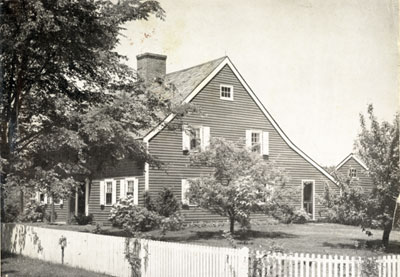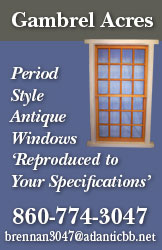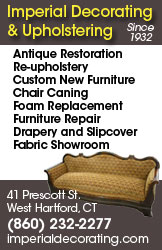
Home Structural Products & Services, Stairlifts
Structural Products & Services, Stairlifts
Furniture, Clocks,
Accessories
Antiques, Folk Art,
Fine Art, Auction Houses
Reprinted from The Magazine Antiques, April 1956
LIVING WITH ANTIQUES
- The Connecticut home of Mr. and Mrs. Frederick K. Barbour
by Alice Winchester
Photographs by W.F. Miller and Co.
| In the hills of northern Connecticut, Mr. and Mrs. Frederick K. Barbour have made a charming country retreat of the eighteenth-century saltbox shown here. Built in 1775, the house is an example of the way early styles persisted in country regions, and doubtless the same is true of many of its furnishings. These are mainly country pieces, and while some represent what we think of as very early styles in America, they may actually have been |  |
| In the parlor the raised paneling of the dado and cupboard doors is what one would expect to find in a house of this period; the mantel, of slightly later type, was installed by the Barbours. The little cherry desk-on-frame with scrolled corner brackets and the cherry low-boy with carved sunbursts are attractive Connecticut Queen Anne pieces. Also the work of local craftsmen are the cherry butterfly table- a typical Connecticut form - and the unusually low-back Windsor, but the high arms and salamander-curved slats of the early turned chair indicate its origin near the Canadian border where French influence was strong. |  |
 |
|
| An English barometer hangs in the corner above the neat little Victorian pump organ. The picture over the mantel is a nineteenth-century dressed print, a three dimensional composition of painting and cutouts from lithographs. Its sporting subject, like the portrait opposite, suggests one of Mr. Barbour's major interests. | |
 |
As in many similar early houses, the old kitchen is now an informal sitting room, where simple furniture is comfortably grouped around the big stone fireplace- early slat-back armchairs and later Boston rocker, Queen Anne and turned tables made in New England. The other end of this long room, of which one wall is covered with horizontal sheathing, is used for dining. Here the table is a large Queen Anne fruitwood dropleaf whose feet are rather curiously bulbous, and the cherry chairs are a set of six in Chippendale design with unusual interlaced splats. Against the far wall, a tea set of New Hall porcelain is displayed on the three-panel blanket chest of oak and pine. The walnut piece opposite is a rarity, with two drawers and scalloped skirt on a frame of turned legs and stretchers; it is believed to have been made in Pennsylvania about 1730. The porcelain tea service on it is Dr. Wall Worcester. |
 |
| In the ground-floor bedroom a colorful pieced quilt covers the Sheraton bed whose turned and reeded maple posts support an arched canopy. A little Empire chair is drawn up to a Hepplewhite mahogany dressing table with the unusual and practical feature of a Vermont marble slab under the mirrored top. Connecticut craftsmanship of high quality is seen in the cherry chest of drawers with oxbow front and fluted corner columns. |  |
| The upper bedrooms have sloping walls and cozy proportions. Here is a low-post maple bed of about 1840 fits under the eaves, opposite a Queen Anne chest-on-frame with deeply scrolled skirt and the long slipper feet associated with Newport work. The mahogany fitted washstand, dating close to 1800, is equipped with spatterware. A distinguished example of its type is the unusually large hooked rug. |
|
 |
Another upper bedroom has an interesting assortment of chairs - slat-back, Windsors, and one of the most entertaining transitional pieces one could find. This a slipper chair, with Chippendale splat back, turned front legs and stretchers of seventeenth-century type, and two Queen Anne pad feet. Here indeed may be seen the hand of the country craftsman. Pure-and simple- Queen Anne, on the other hand, are the dressing table and mahogany stool, the latter a rarity in American work; and true seventeenth-century in character, though probably dating later, is the high ball-footed chest of drawers. The little ball-footed box on it is inscribed T H / 1743. In one corner of the room is arrayed Mrs. Barbour's collection of early miniature furniture. |
 |
|
 |




